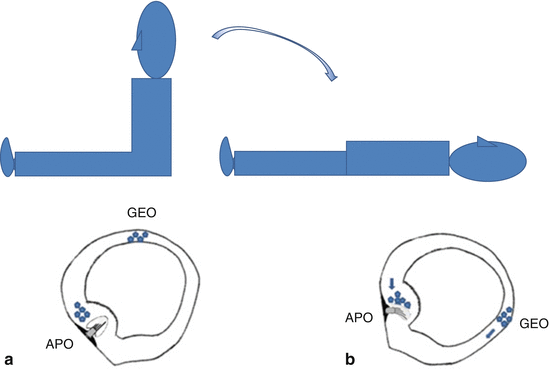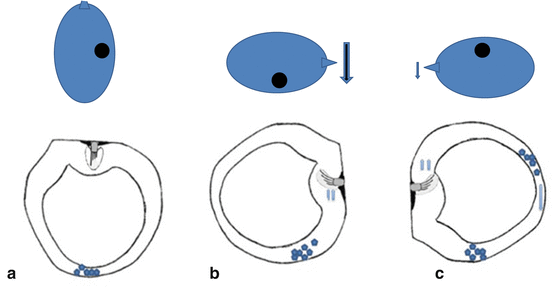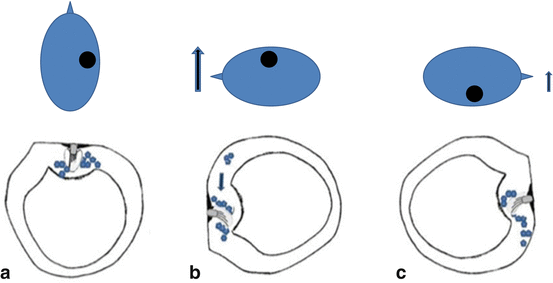Fig. 12.1
Pathomechanism in left posterior canal canalolithiasis. (a) In the sitting position, the head is turned 45° to the left and debris are located in the lower part of the PC. (b) The patient is then rapidly brought into a left head hanging position and particles fall in ampullofugal direction, provoking a mixed upbeating-torsional nystagmus (upper pole beating toward the affected left ear). (c) The patient is next returned to the upright position and debris fall back in ampullopetal direction, provoking a less intense nystagmus in the opposite direction
Table 12.1
Main features of typical paroxysmal positional nystagmus due to posterior canal canalolithiasis (Dix-Hallpike maneuver)
Direction and plane | Torsional with the upper pole of the eye to the lower ear and vertical (to the forehead). Reverses its direction when returning to the sitting position |
Latency | 1–10 s |
Duration | Usually 20–30 s (<1 min) |
Fatigability | Reduction of intensity by repeating the maneuvers |
Temporal profile | Paroxysmal (rapid “crescendo” – slow “decrescendo”) |
If otoconial debris are attached to the cupula of the PC (cupulolithiasis), the Dix-Hallpike maneuver will similarly provoke a positional nystagmus. The cupula is deflected down, toward the canal, by gravity, because adherence of debris makes it heaviest with respect to the endolymph. Positional nystagmus due to PC cupulolithiasis should have the same features as those due to canalolithiasis according to plane and direction but will be less intense and more prolonged, as reasonable to expect but also deduced from mathematical models [12].
12.3.2 Lateral Canal BPPV
Positional nystagmus from the lateral canal is reliably elicited by the “Pagnini-McClure test,” also called the “supine head roll test,” a maneuver that acts in a plane parallel to that of the lateral canal [13, 14]. The patient is first brought from the sitting to the supine position, with the head straight (nose upward) and bent about 30° forward, looking for the appearance of any positional nystagmus. Then the patient’s head is rolled 90° to one side. After that, the head is rotated 180° to the other side, looking for changes in the direction and intensity of nystagmus. According to the different locations of otoconial debris in the canal, LC-BPPV can be divided into two variants, the more common one with geotropic nystagmus and the less common one with apogeotropic nystagmus.
12.3.3 Geotropic Variant
Once otoconial debris have entered the lateral canal, they move under the force of gravity, tending to settle at the bottom of the canal, far from the cupula. When the patient is moved from the sitting to the supine position with the head straight, the debris gravitate downward to the lower portion of the canal, away from the ampulla. This causes an inhibitory ampullofugal endolymphatic flow and a mild horizontal nystagmus toward the unaffected ear [15] (Fig. 12.2). The subsequent rotation of the head toward the affected ear causes the particles to fall toward the ampulla, producing an excitatory flow and an intense horizontal nystagmus beating toward the lower ear. It is named geotropic because it beats toward the ground. When the head is then rolled to the other side (to the unaffected ear), the particles fall in the opposite direction and cause an inhibitory ampullofugal stimulus. This provokes an inversion of nystagmus direction, i.e., beating toward the opposite, healthy ear (again geotropic) (Fig. 12.3).



Fig. 12.2
Sitting-supine positioning test in lateral canal BPPV. The patient is rapidly moved from the sitting (a) to the supine (b) position with the head straight. The maneuver causes otoconial debris to gravitate away from the ampulla, to the most dependent part of the lateral canal, provoking an ampullofugal flow and positional nystagmus beating toward the normal ear (geotropic). If located close to the ampulla, particles move toward the cupula, provoking an ampullopetal flow and nystagmus beating toward the affected ear (apogeotropic)

Fig. 12.3
Right lateral canal BPPV: supine head roll test. Geotropic positional nystagmus. (a) The patient lies in supine position with the head straight and the debris in the most dependent part of the right lateral canal. (b) Rolling the head to the right side, particles fall toward the ampulla, producing an ampullopetal flow and intense right-beating (geotropic) nystagmus. (c) Rolling the head to the left side, particles move in the opposite direction, producing ampullofugal flow and left-beating (geotropic) mild nystagmus
Geotropic positional nystagmus, when paroxysmal, is always due to canalolithiasis and does not require differential diagnosis. There are reports of horizontal positional nystagmus, geotropic, stationary, and long lasting, attributed to light cupula [16].
12.3.4 Apogeotropic Variant
The apogeotropic variant is due to a different position of particles inside the lateral canal. According to cupulolithiasis theory, they can be attached to the cupula, on the canal side, on the utricular side, or both, and when the head is turned on its side, the heavy cupulae are deflected by gravity. When the head is rotated so that the affected side is down, the deflection will be toward the ground, and the resulting nystagmus will result from an inhibitory stimulus, that is, toward the opposite, normal, side (apogeotropic). In contrast, when the head is rotated so that the affected ear is up, the heavy cupulae will deflect toward the utriculus and the resulting “excitatory” nystagmus will be directed toward the uppermost affected ear (again apogeotropic). The intensity of nystagmus again reflects the difference in the stimulation (excitatory/inhibitory) of vestibular end organs, with the strongest nystagmus beating toward the affected ear.
There is also the possibility that the apogeotropic variant is due to canalolithiasis. If debris are located near the ampulla of the lateral canal, on its anterior part, they can move in the opposite direction with respect to the geotropic variant (Fig. 12.4).


Fig. 12.4
Right lateral canal BPPV: supine head roll test. Apogeotropic positional nystagmus. (a) The patient lie in supine position with the head straight and particles located close to the ampulla of the right lateral canal. (b) Rolling the head to the left side causes the particles to fall toward the cupula, triggering an intense right-beating (apogeotropic) nystagmus due to the excitatory stimulus (canalolithiasis). The same nystagmus could be elicited to be the deflection of the ampulla caused by the weight of particles strictly close or attached to the ampulla (cupulolithiasis). Positional nystagmus due to cupulolithiasis should be less intense and more prolonged. (c) Rolling the head to the right side, the particles move in the opposite direction, producing less intense left-beating (apogeotropic) nystagmus
Cupulolithiasis should be characterized by less violent and more persistent positional nystagmus. Canalolithiasis is more likely when positional nystagmus is very intense and when the apogeotropic variant is easily transformed into the geotropic one, by diagnostic or therapeutic maneuvers. The characteristics of positional nystagmus due to LC-BPPV are shown in Table 12.2.
Table 12.2
Main features of typical paroxysmal positional nystagmus due to lateral canal canalolithiasis/cupulolithiasis (supine head roll test)
Direction and plane | Horizontal, geotropic (toward the lower ear), or apogeotropic (toward the upper ear). Reverses its direction when rolling the head to the opposite side |
Latency | 0–10 s |
Duration | Usually 30–40 s (<1 min). More prolonged with cupulolithiasis |
Fatigability | Probable (difficult to assess) |
Temporal profile | Paroxysmal (rapid “crescendo”-slow “decrescendo”). Not paroxysmal with cupulolithiasis (low “crescendo”-slow “decrescendo”) |
The diagnostic key for LC-BPPV is the finding of a horizontal and direction changing positional nystagmus evoked by the supine head roll test. Its latency is usually shorter than that of the PC-BPPV; it is generally more intense and lasts longer, usually less than a minute. It is sometimes necessary to repeat the diagnostic maneuvers, because the first rotation may not have evoked the positional nystagmus. Repetition of the rotation is also helpful to identify the more intense nystagmus and the pathological ear. Patients with LC-BPPV may also exhibit a mild “spontaneous” horizontal nystagmus while in the sitting position [13]. This pseudo-spontaneous nystagmus is strongly modulated by head position and movement [17, 18].
Unlike the geotropic variant, the apogeotropic variant requires a differential diagnosis with dysfunction of the central vestibular system, especially if positional nystagmus is not paroxysmal. The best way to obtain a correct diagnosis is probably by exclusion. Posterior fossa lesions quite often produce symptoms that are difficult to ignore and lead to additional ocular motor abnormalities such as gaze-evoked nystagmus, impaired smooth pursuit or saccades, and other neurological abnormalities. A clinical history of previous episodes of PC-BPPV is often a clue. In cases of doubt, especially if apogeotropic nystagmus does not disappear in a few days or does not change its direction, an MRI of the brain is necessary.
12.3.5 Anterior Canal BPPV
Anterior canal (AC) BPPV is much rarer than LC- and PC-BPPV because of the superior anatomical position of the canal. It is improbable for debris to enter this canal, and self-clearing is facilitated because the posterior arm of this canal descends directly into the common crus. AC-BPPV can be detected with both Dix-Hallpike maneuvers since the anterior canals are coplanar to the PCs of the opposite side. In fact, the best way to elicit a positional nystagmus due to the ACs is with straight head hanging, by bringing the patient to the supine position with the head 30° (or even more) below the earth horizontal [19, 20]. When the Dix-Hallpike maneuver provokes a mixed vertical-torsional nystagmus and the fast phase of the vertical component is downbeating, anterior canal involvement may be responsible. The torsional component beats with the top pole of the eye toward the upper ear. This is because the Dix-Hallpike maneuver on one side acts on the plane of the AC of the contralateral side. Otoconial debris will fall away from the ampulla, provoking an excitatory stimulus to the ipsilateral superior rectus and to the contralateral inferior oblique muscles, that is, the antagonists of the muscles connected to the PC.
In fact, canalolithiasis of the AC is still debated because patients with positional downbeating nystagmus (pDBN) show some features that are difficult to justify. Nystagmus can be vertical-torsional but is often purely vertical, relatively sustained, and of low intensity. Very often, the nystagmus does not reverse its direction when the patient is returned to the sitting position, in spite of the contemporary presence of important vertigo or unsteadiness. Some of these features may be justified [19], some not. Moreover, patients with pDBN are more common than previously reported [11], probably with the same frequency of presentation as LC-BPPV in the geotropic form, in contrast to the anatomy of the labyrinth. Many of them were previously affected or will develop a typical PC-BPPV. The course of the syndrome, often characterized by a rapid and spontaneous remission, is benign, but its relationship to canalolithiasis of the AC needs to be confirmed. Other pathomechanisms must also be considered. Theoretically, pDBN can also be observed in atypical forms of PC-BPPV, when the debris are located in the non-ampullar arm of a PC and move in a direction opposite to the expected one, similar to the pathomechanism of apogeotropic nystagmus in the lateral canal [21]. Furthermore, debris could also be located in the short arm of a PC [22], causing deflection of the cupula due to debris falling into the utriculus.
On the other hand, it must be emphasized that a pDBN can be due to damage to the vestibular cerebellum even though this is improbable when positional nystagmus is the only sign and/or there is a rapid resolution.
12.4 Treatment of BPPV
The therapy of choice for BPPV is physical treatment. Physical therapy aims to eliminate the episodes of positional vertigo by forcing the otoconial debris to come out of the semicircular canals. Special movements and positions of the head and body are used to trigger a series of clinical events which are consistent with the canalolithiasis hypothesis. Therapies for PC- and LC-BPPV have been validated. On the other hand, specific diagnostic criteria and effective treatment for the anterior canal variant of BPPV are still illusive. Surgery and medications play a minor role in BPPV. Below, we summarize the main therapeutic maneuvers for BPPV, details of which can be found in the references.
Stay updated, free articles. Join our Telegram channel

Full access? Get Clinical Tree


